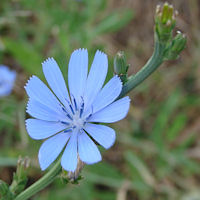 |
Cichorium intybus
Wild Chicory, Endive.
Cama-roja, Endívia, Mastagueres, Xicoira, Xicoira dolça (Cat.)
New shoots, red and hardly through the ground, were traditionally blanched and used in salads in Mallorca. The root was used as a coffee substitute or added to it. Widespread in fields and verges.
|
|
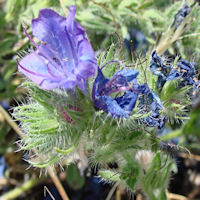 |
Echium vulgare
Herba del vibre, cul de pors. (Cat.)
Blue Viper’s Bugloss, Blueweed, Bluebottle.
The tubular flowers start pink and turn a vivid blue with pinkish stamens.
Widespread. Found in dry areas and on waste ground. Popular with bees.
Drought hardy
See also Echium plantagineum
|
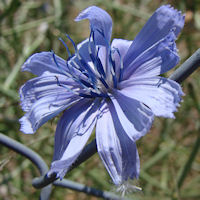 |
Centaurea cyanus
Blauet (Cat.)
Cornflower, Bachelor's button, Bluebottle
Deep blue flowerhead. Not to be confused with the more widespread
Cichorium intybus( see above). Previously prized for its blue
pigment for dyes. Edible flower used as culinary decoration or garnish.
Effective in treating conjunctivitis or reviving tired eyes. Fields and roadsides.
|
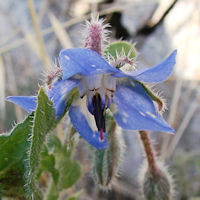 |
Borago officinalis
Borratja., Herba de la tos, Orella d'ós, Pa-i-peixet. (Cat.)
Starflower
Annual herb with bristly or hairy stems. Flowers with five petals are bright
blue occasionally pink. With a flavor similar to cucumber, it can be used as a
vegetable, as a herb or as a culinary garnish. Widespread in hedgerows and fields.
|
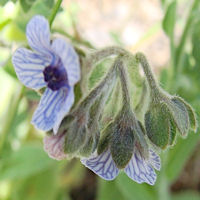 |
Cynoglossum creticum
Aferragós, Besneula, Llapassera, Llengua de ca, Llengua d'ovella, Maneula. (Cat.)
Blue Hound’s Tongue
Member of the borage family. Biannual with hairy leaves. Bluish flowers with
dark blue veins appear in second year. Its bright green fruit, in clusters of four
forming a cross or a diamond, are covered with tubercles or nodules. Height 20-80 cms.
Flowering at the end of spring. Widespread along roads and paths and disturbed ground.
|